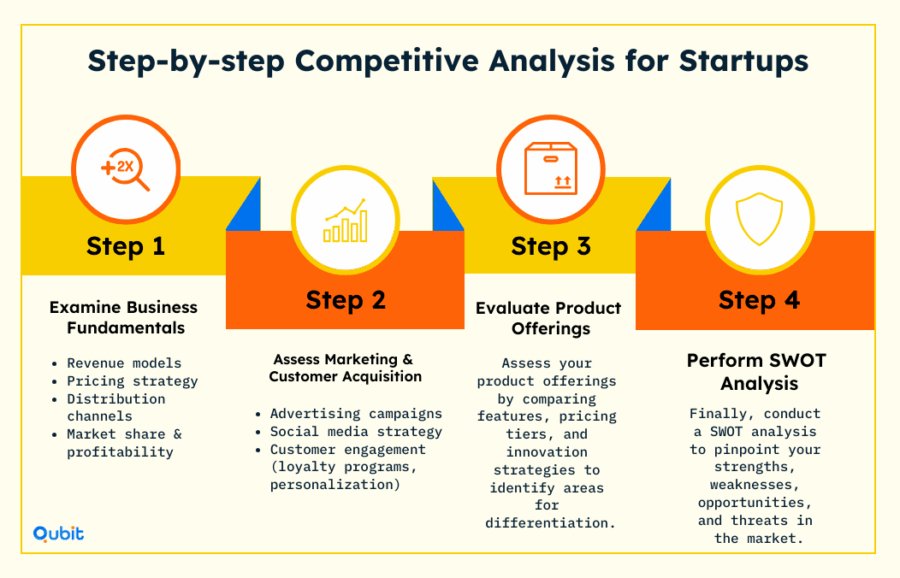Understanding your competitive landscape is essential for crafting strategies that ensure long-term success. A thorough analysis of your rivals provides insights into market trends, customer preferences, and potential gaps in your approach. By employing the best market research tools for startups, businesses can gather competitive intelligence to refine their strategies and stay ahead of rivals. This blog explores the importance of analyzing your competitors, offering actionable insights to help you make informed decisions.
Let’s jump right in!
Why Monitor Your Competitors?
Keeping tabs on competitors is more than just a business tactic—it’s a strategic necessity. By conducting competitive landscape analysis, businesses can uncover untapped market gaps that competitors may have overlooked. These insights pave the way for innovative offerings that address unmet customer needs.
Competitor analysis also plays a pivotal role in refining product development and marketing strategies. Understanding how competitors position their products and engage their audience allows businesses to craft more compelling solutions and campaigns. This systematic review of competitor offerings ensures that your business remains relevant and competitive. Understanding how to find investors for startups often begins with a solid grasp of competitive landscape analysis, which ensures you have the data needed to position your business effectively.
Additionally, continuous monitoring safeguards against potential disruptors. The market evolves rapidly, and staying informed about emerging trends and new entrants helps businesses adapt proactively rather than reactively. In essence, competitor monitoring is not just about observing—it’s about staying ahead in the game.
Identifying Your Competitors
Understanding who your competitors truly are is a foundational step in mapping the competitive landscape and designing your market research techniques for startups. Begin by analyzing customer overlaps—identify businesses targeting similar audiences and addressing comparable needs. Examine product categories to uncover companies offering alternatives or substitutes to your offerings. Additionally, assess how others solve the same problems your business addresses, as this can reveal indirect competitors you might otherwise overlook.
Misclassifying competitors can lead to strategic errors, such as wasted resources or misguided priorities. For instance, focusing on a company generating significant revenue in a different niche may divert attention from actual rivals.
Properly identifying competitors ensures your resources are allocated effectively and your strategies remain aligned with market realities. This clarity strengthens your competitive positioning, enabling you to make informed decisions and stay ahead in your industry.
Effective Strategies to Discover Competitors
Understanding your competitive landscape mapping is crucial for refining business strategies. Identifying competitors involves exploring multiple channels, each offering unique insights into market dynamics.
1. Direct Customer Engagement
Customers are often a rich source of information about competitors. By asking targeted questions during interactions, businesses can uncover competitors that may not be visible through traditional research methods. This approach often reveals niche players or emerging brands that are gaining traction.
2. Social Platforms for Competitor Discovery
LinkedIn serves as a powerful tool for identifying competitors. Its "Similar Pages" feature can highlight businesses operating in the same domain, offering insights into emerging competitors. Additionally, LinkedIn profiles and company pages often provide valuable data on market positioning and strategy.
3. In-Depth Keyword Research
Keyword research tools like Semrush are indispensable for mapping competitors in the digital space. Semrush provides relevant data about competitor keywords and search rankings, helping businesses understand how competitors attract traffic and engage audiences. This method bridges online behaviors with actionable strategies.
4. Personal Market Exploration
Firsthand market experience remains one of the most authentic ways to identify competitors. Attending industry events, visiting trade shows, or conducting field research can uncover real-time insights into competitor activities and trends. This direct approach complements digital research by offering a tangible perspective on the market.
For more information on how macro trends can shape competitor behavior, explore analyzing startup industry trends.
Step-by-Step Competitive Analysis Process
Understanding competitive landscapes requires a structured approach to uncover valuable insights. A detailed competitive analysis begins with organizing research into a matrix, which simplifies comparisons across business fundamentals, marketing strategies, customer acquisition methods, and product offerings. This matrix allows for a clear view of where competitors excel and where gaps exist.

1. Examine Business Fundamentals
Start by evaluating the foundational aspects of your competitors' operations. Analyze their revenue streams, pricing models, and distribution channels. Detailed analysis of key business metrics, such as market share and profitability, reveals competitive positioning and helps identify opportunities for differentiation.
2. Assess Marketing and Customer Acquisition Strategies
Next, focus on how competitors attract and retain customers. Review their advertising campaigns, social media presence, and partnerships. Pay attention to their customer engagement tactics, such as loyalty programs or personalized communication. These insights can help refine your own marketing approach.
3. Evaluate Product Offerings
Dive into competitors' product features, pricing tiers, and innovation strategies. Compare these elements to your own offerings to identify areas for improvement or potential advantages. This step is crucial for understanding how competitors meet customer needs and where they might fall short.
4. Perform a Robust SWOT Analysis
Finally, conduct a structured SWOT analysis to pinpoint strengths, weaknesses, opportunities, and threats. This process provides clarity on areas where your business can excel and highlights risks posed by competitors. Reference established frameworks and academic perspectives on competition through resources like Comp Analysis for deeper insights.
Discovering Reliable Competitor Data Sources
Understanding the competitive landscape begins with identifying trustworthy data sources. Public companies, for instance, provide a wealth of information through disclosures like annual reports and earnings calls. These resources often offer more transparent data compared to private firms, making them a valuable starting point for competitor analysis.
For deeper insights, platforms such as Crunchbase are indispensable. Crunchbase often reveals a company's growth stage based on funding, which can inform competitive positioning. Similarly, Glassdoor provides employee satisfaction ratings, shedding light on internal stability and workplace culture. To validate or cross-reference data, Dealroom offers a comprehensive startup database, enhancing the accuracy of your analysis.
Integrating these tools with advanced customer segmentation strategies can further refine your approach. Effective customer segmentation strategies allow businesses to target key demographics, enhancing their ability to outperform competitors in niche markets.
Using Competitor Insights for Strategic Advantage
Understanding competitor dynamics can transform your business strategy into a proactive force. By integrating competitor insights to inform internal strategic shifts, businesses can identify gaps and opportunities that drive innovation. For instance, aligning these insights with a holistic marketing plan ensures your brand stays relevant and competitive.
A well-supported pitch deck is another area where competitor analysis proves invaluable. Highlighting your unique strengths while addressing market gaps builds investor confidence. For example, incorporating data-driven insights into your fundraising strategy ensures that your competitive analysis translates into investor-ready insights, building trust and credibility.
Focused investor targeting is equally critical. By understanding which investors align with your industry and goals, you can reduce wasted efforts and maximize your outreach impact. Continual monitoring of competitor activities further enables proactive market adjustments, keeping your business ahead of emerging trends.
Competitor insights are not just about observation; they’re about action. Whether refining your pitch deck, optimizing investor targeting, or adapting to market shifts, these insights empower businesses to make strategic decisions that drive growth and innovation.
Assessing the Value of Competitor Analysis
Understanding the competitive landscape analysis offers both immediate and long-term advantages for businesses. A well-executed analysis sharpens short-term decision-making by identifying market gaps and opportunities. Strategically, it lays the foundation for sustained growth by refining a company’s unique value proposition (UVP). A clear Unique value not only differentiates your business in a crowded market but also ensures your offerings resonate with target audiences.
Moreover, data-driven insights from competitor analysis empower businesses to anticipate market shifts and maintain a competitive edge. For instance, 90% of large enterprises invest in competitive intelligence to sustain market leadership. This proactive approach helps organizations stay ahead of trends and competitors alike.
Ultimately, a thorough competitor analysis is more than a tool—it’s a strategic necessity for businesses aiming to dominate their industries and secure long-term success.
Conclusion
Crafting a competitive strategy begins with identifying key competitors, sourcing reliable data, and conducting structured analyses. These steps transform raw information into actionable insights that can shape strategic decisions. Equally important is presenting these findings through a clear, narrative-driven pitch deck. By connecting competitive data to tangible outcomes, you create a compelling story that resonates with stakeholders and drives results.
If you're ready to uncover key investor insights and refine your competitive strategy, let us help. Contact us through our Investor Discovery and Mapping service today.
Key Takeaways
- Competitive analysis is integral for identifying market gaps and refining strategic decisions.
- Diverse research methods, including customer feedback and keyword analysis, reveal hidden competitor insights.
- A structured framework using SWOT and PEST enhances decision-making.
- Regular updates to competitor data enable proactive strategy adjustments.
- Leveraging these insights improves investor targeting and pitch deck effectiveness.
Frequently asked Questions
How to do competitor analysis for a startup?
Begin by identifying both direct and indirect competitors. Use customer feedback, online research, and keyword analysis to pinpoint who your competitors are. Once identified, create a competitor matrix and perform a SWOT analysis to evaluate their strengths, weaknesses, opportunities, and threats.


 Back
Back



